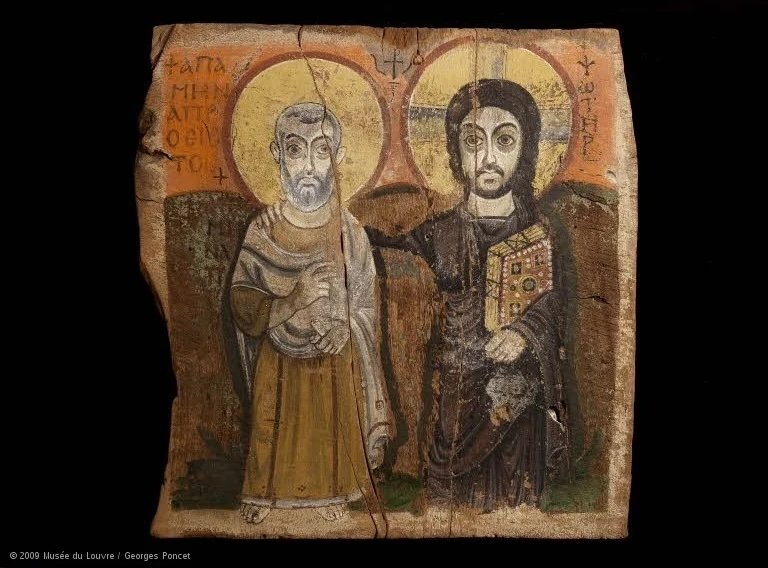Icon of Christ and St Menas
At one of our training weeks, this icon spoke to me about my relationship with Jesus as a friend rather than a far-off mystery. I have a copy from a Greek Monastery on my wall and sketched an interpretation for the site icon above. It also seemed to speak of the companion aspect of spiritual direction.
The original is held in the Louvre.
Text from the exhibition, The Byzantine Legacy created by David Hendrix in 2016.
This exceptional painting on wood comes from the monastery of Bawit in Middle Egypt. Dated to the 8th century, it represents Christ (easily recognizable by his halo with a cross) and Abbot Mena, the superior of the monastery at the time. The abbot holds a scroll in his left hand; this may have contained the rules of his monastery.
A complete painting on wood
The two painted figures are depicted on a wood support, which is a perfect square. This object was discovered in Bawit in Middle Egypt, where the remains of an extremely large monastery have been found. The French archaeologist Jean Clédat discovered this monastery in 1900 while he was exploring and excavating in the region. His archaeological notes do not, however, indicate the exact location where this painting was discovered. Despite a few large cracks, it is in good condition, thanks to restoration. The work can be considered to be complete, which is rare for a painting.
The two figures
The two figures are depicted in a frontal pose against a landscape. A few traces of vegetation can still be seen at their feet. The background consists of hills with a sunset sky, from which the halos of the figures seem to be rising.
Christ, to the right, is slightly taller than the figure on the left. His halo has a crucifer, and the inscription "Savior" is written near him. Christ has a short beard and wide, lined eyes. He wears a tunic and a scarf, and in his left hand holds a Book of the Gospels, richly adorned with pearls and gems and fitted with metal clasps on the side. In a sign of introduction and as a protective gesture, his right hand is placed on the left shoulder of the father superior, a very important man in the monastery. He can be identified by the inscription placed to the left of his halo, "Apa Mena superior," repeated directly below, and by the scroll in his left hand. This scroll may contain the rule of the monastic institution. Mena has a gray beard and is wearing a tunic and a scarf. He makes a sign of the blessing with his right hand.
The oldest Coptic icon
A cross, framed by a coronis, or a punctuation sign used in Greek and Coptic manuscripts from the era, is placed between and slightly above the two halos. The overall work is extremely elegant and serene, and is the oldest-known Coptic icon.

